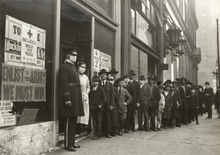Anti-Mask League of San Francisco
The Anti-Mask League of San Francisco (to German anti-masks League of San Francisco ) was to protest against the order, an organization that was founded in San Francisco, California , during the 1918 influenza pandemic to wear masks .
background
In the fall of 1918, the first cases of the Spanish flu appeared in San Francisco. The first documented case occurred in late September; by mid-October, the city had more than 2,000 cases.
The city's health ministry enacted various measures to contain the disease, such as: B. The prohibition of gatherings, the closing of schools and theaters and the instruction of the citizens to avoid crowds. The wearing of masks was prescribed for people who came into direct contact with customers on a professional basis (hairdressers, hotel and pension employees, bank tellers, druggists, salespeople and all other persons who serve the public). Then, on October 25, the city issued an ordinance requiring "every San Francisco resident and visitor" to "wear a mask in public or in a group of two or more, except during meals."
The initial acceptance of the mask regulation was high; an estimated four out of five people wore a mask in public. The Red Cross sold masks at the port's terminal for people arriving by ferry. People who did not wear a mask or who improperly wore a mask were charged with "disturbing the peace" and then given a warning and fined mostly US $ 5, which the Red Cross benefited from.
These included a congressman, a judicial officer, a rear admiral of the Navy , Mayor Rolph and the health officer Hassler. All of them were filmed by a police photographer who sent copies of the prints to his boss. Hassler paid a $ 5 fine on the spot and admitted that his mask may have fallen off while smoking a cigar. A few days later, Mayor Rolph was shown a photo of his unmasked face and was fined $ 50 by his own police chief.
The mask ordinance was repealed with effect from November 21, but the flu cases increased again. A new mask ordinance came into force on January 17, 1919.
Formation of the league
There was already resistance to the first prescription. The new 1919 ordinance sparked more serious opposition and the Anti-Mask Association was formed.
Members of the league included doctors, citizens, civil rights activists. An estimated 2,000 citizens attended a meeting on January 25th. Some members of the league wanted to collect signatures for a petition to end the mask requirement, while others called for the city health official to resign. The debate was heated.
In addition to the Anti-Mask League, some health officials from other cities also claimed that masks were not necessary. The San Francisco city health officer criticized the state health department secretary for questioning the effectiveness of masks and said the state health department's stance encourages the anti-mask league.
On January 27, the League submitted a petition to the City Board of Trustees, signed by Ms. EC Harrington as chairman, calling for the Mask Ordinance to be repealed. Newspapers around the world took notice of the protesting organization. Mayor Rolph once again announced the repeal of the mask ordinance after the municipal council found in a meeting that the disease situation had improved so much that the measure was no longer necessary. San Francisco repealed the Mask Ordinance effective February 1, 1919.
See also
Individual evidence
- ↑ a b Peter Lawrence Kane: The Anti-Mask League: lockdown protests draw parallels to 1918 pandemic . In: The Guardian . April 29, 2020, ISSN 0261-3077 ( theguardian.com [accessed May 1, 2020]).
- ^ A b c d San Francisco, California and the 1918-1919 Influenza Epidemic . Retrieved April 19, 2020.
- ↑ San Francisco, California and the 1918-1919 Influenza Epidemic | The American Influenza Epidemic of 1918: A Digital Encyclopedia. Retrieved May 1, 2020 .
- ↑ "Ringside Picture Reveals Maskless fans to Police", San Francisco Chronicle, 20 Nov. 1918, 9
- ^ Katie Canales: Photos show how San Francisco emerged from a lockdown too soon during the 1918 Spanish flu pandemic, leading to an even deadlier second wave that rampaged through the city . Retrieved April 22, 2020.
- ^ A b c Alfred W. Crosby: America's Forgotten Pandemic: The Influenza of 1918 ( en ). Cambridge University Press, July 21, 2003, ISBN 978-0-521-54175-6 , pp. 112-113.
- ^ Samuel K. Cohn Jr: Epidemics: Hate and Compassion from the Plague of Athens to AIDS ( en ). Oxford University Press, 2018, ISBN 978-0-19-881966-0 , p. 440.
- ↑ Municipal Journal ( en ). Municipal Journal and Engineer, Incorporated, 1919, p. 111.

